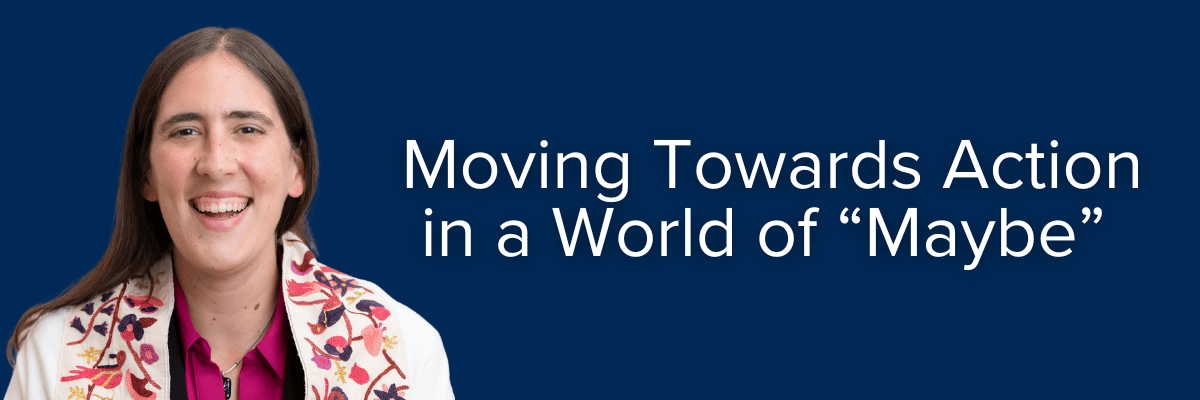Happy Purim! Happy Purim?
We are so excited to celebrate with many of you tonight at what’s sure to be a wonderful shpiel and Purim Palooza … and so excited to celebrate with many more over the weekend, as our Purim celebrations continue for community members of all ages. We could all use a little more joy in our lives – and I hope that for many of us, this holiday can bring just that.
And yet. Here we are in yet another year where for many of us, aspects of the Purim story feel quite complex, and maybe a little too real.
The first time an aspect of Purim celebrations felt Too Real to me was March of 2020. For many synagogues in the New York area, including the synagogue where I was a student rabbi at the time, Purim was the first holiday canceled by COVID lockdowns – not reimagined, because we didn’t quite know how to do that yet, just canceled. Meanwhile, for many synagogues outside of New York, it was the last big holiday the community celebrated together before the world turned upside down. On Purim, we are taught, the world is v’na’hafok – turned upside down. And it sure felt upside down that year, in a terrifying way. “Too real, Purim,” I remember thinking from my little Brooklyn apartment where I was learning how to use zoom and very much not wearing a costume, “Way too real.”
Last year, in a very different way, for many people in our TRS community and beyond, Purim brought a powerful and painful reckoning – this time, because of the violence in the Book of Esther, and the ways different moments of the (very much fictional, but also suddenly Far Too Real) story seemed to reverberate in our world. (And here I will parenthetically commend a sermon that Rabbi Schwartzman gave about this last year, exploring some of the many challenges of different aspects of the Purim story for readers in 2024 – and perhaps today too – and different Jewish approaches to these challenges.) For some of us, these questions from last year linger, perhaps a little more resolved, or perhaps only amplified by so much of what we’ve lived through since.
And here we are … at Purim again! And it would be more than enough (dayenu) if the only things making this Purim a little bizarre were the ripples of these past challenging years, still with us somewhere deep in our bones … but of course, we are also facing many new challenges.
Here in 2025 (5785), so much about our country, and our personal lives, and the lives of many of our friends and neighbors, is v’na’hafok, turned upside down. And many of us feel very uncertain about how to bring about positive change. What do we do with a joyous holiday like Purim at a time like this?
One of the gifts of returning to the story of Purim every year is that each year a different part of the story jumps out, as though to speak to our present moments. And this year, I found myself thinking a lot about Esther’s transition from object to subject.
The Book of Esther (which we’ll hear excerpts of tonight, before the shpiel) begins, not with Esther herself, but with her future husband, King Ahasuerus. We spend more than a chapter getting to know Ahasuerus before Esther comes on the scene, and the main thing we learn about Ahasuerus is – he is a guy who is used to getting what he wants. When we finally do meet Esther (in Esther 2:7-8), she is being taken to the palace to be considered as a potential new wife for the king.
We have no idea if this is something Esther wants or doesn’t want because the text doesn’t tell us anything about her desires. But we also know that whatever she may or may not want, she doesn’t really have a choice – a message the Megillah underscores by making Esther the object, rather than the subject, of the first several sentences about her life and experiences. When she first becomes the subject of a sentence with an active verb, it is a negative: לֹא־הִגִּ֣ידָה אֶסְתֵּ֔ר אֶת־עַמָּ֖הּ, lo higida Esther et amah, Esther didn’t tell [the king] of her people (Esther 2:10). The first active thing Esther does is hide.
It is only in Chapter 4, after a decree has gone out (at Haman’s behest) that all of the Jews of the kingdom will be killed, that Esther begins to become more of a subject, an agent of change (both grammatically and as a matter of plot). When her cousin, Mordecai, encourages her to approach the king on behalf of the Jewish people, she is initially fearful (she might lose her life), but eventually persuaded. And the word that seems to change a great deal for her is a small word – “maybe,” or in Hebrew, אולי (oo-li). Mordecai, Esther’s cousin, says to her: “maybe it was for a moment like this that you came to power” (Esther 4:14).
Like us, Mordecai and Esther don’t have any special powers to predict the future or assess with certainty why some things (both terrible and beautiful) happen in their world. The best they have is “maybe” – “oo-li.” Like the reminder that change is part of our world and everything can be turned upside down, “oo-li” is a sort of double-edged promise, containing beautiful and terrible possibilities. On the one hand, maybe! But on the other hand … maybe not?
Living with contingencies can be terrifying, and paralyzing. But the Book of Esther reminds us: living with contingencies can also help us be brave. Not knowing what comes next can be, paradoxically, an invitation to believe in ourselves. What if we, like Esther, choose to believe that we each came to be exactly who we are, exactly in this moment, because the world needs us, exactly as we are? What might be possible, for us and for our world?
______________________________
V‘nahaFok hu (ונהפוך הוא) – in an instant, everything can be turned upside down. These words are a quote from Esther 9:1. V‘nahaFok hu is not just a quote, but also one of the key themes of Purim. It reminds us of many elements of the story in the Megillah (Book of Esther) in which suddenly, for everyone, everything changes, and they also describe the ways Jewish communities have come to celebrate the holiday over time – by joyously, irreverently, putting on costumes and turning many things in our world upside down. V‘nahaFok hu reminds us that change is possible, that we don’t know what will come next – which can be both a blessing and a challenge.


